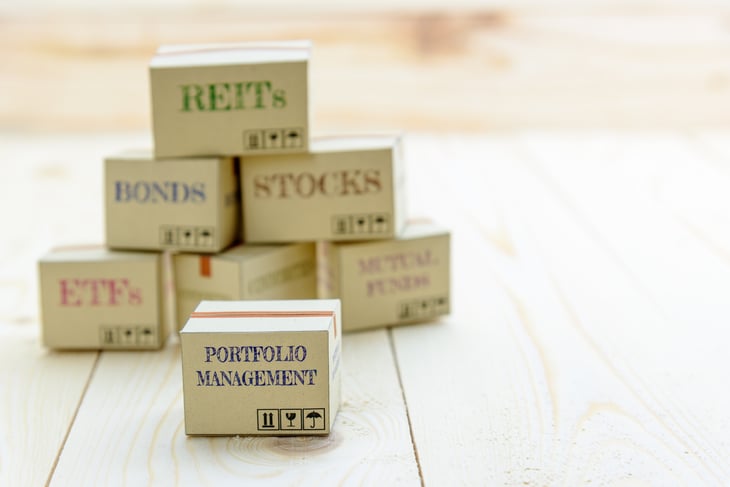
Editor's Note: This story originally appeared on NewRetirement.
If you’re reading this, you’re likely someone who: saves money, has built up some assets, and is starting to think about how to create a retirement drawdown strategy — a plan for how to turn your assets into income that will last for life.
Having a sound retirement drawdown strategy and keeping to it is crucial if you want to be able to live comfortably in retirement and not spend time worrying about outliving your savings. Most of the financial services industry has been focused on helping people accumulate or save and invest (and their business models are built on this).
How to decumulate, or drawdown, and generate retirement income in a tax-efficient way is a complex topic that is starting to get more attention. Keep reading for five detailed steps to decumulation — a retirement drawdown strategy.
1. Determine How Much You Need To Withdraw

In order to set your withdrawal plan, you first need to know how much you’ll need and want. From a risk management perspective, try to get the “need to live on” amount as low as possible. Here are four ways to do that.
Optimize Your Lifestyle and Expenses

Take a hard look at your expenses and find ways to get as efficient as possible — this is a huge driver of how much you need in retirement. Build a budget, go through all of your expenses, especially recurring expenses. Get rid of debt (credit card, car payments, student loans — ideally pay off your mortgage). Consider where you want to live, since that is a huge driver of taxes and expenses in retirement.
Budget for Out-of-Pocket Health Care

Consider health care and insurance costs. Out-of-pocket health care costs for a 65-year-old couple are more than double what the average household has saved. Read up on how Medicare and Medicare Supplemental Insurance work.
Go Really Frugal

There is an interesting movement called Financial Independence Retire Early (FIRE) — the FIRE Community has some great lessons for traditional retirement people around being frugal/efficient and mindful.
Get Detailed About Future Budgeting

What you are spending today is not what you’ll be spending next year or in 10 years. The reality is that for most people, expenses drop by about 10% per decade in retirement.
2. Consider Guaranteed Income and How You’ll Generate It

The more income you have in retirement, the less you need to draw down from your assets, so think carefully about this one. Here are four ideas to consider.
Factor in Part-Time Work

When many people think of retirement, they think “no more work,” but the reality is that part-time work is part of many people’s retirement — for income, for engagement, to give back, or for social reasons.
It can be a way of breaking down the problem of retirement income into smaller pieces — for example, if you were making $100,000 a year and think you only need $75,000 annually in retirement, then Social Security ($25,000) + part-time work ($25,000) + drawdown savings ($25,000) sounds like a more achievable plan.
Working part time also gives you a hedge if there’s a big market correction — you’ll give yourself more time for your investments to rebound and you might be able to dollar-cost average into the lower market prices.
Maximize Social Security

Recently, more people have started getting smarter and are delaying the start of their Social Security benefits.
However, about 33% claim Social Security at 62, which is generally a bad idea. Basically, if you think you’ll have a long life, then you should delay as long as possible — since you’re effectively “buying” an inflation-adjusted lifetime annuity backed by the U.S. government at a lower rate than you could buy it on the private market. You can explore your break-even age for Social Security here.
If you’re married, have the couple’s highest earner delay until 70 — here’s why: 21% of married couples and 43% of unmarried people rely on Social Security for 90% of their income.
Explore Income-Generating Investments

Originally, most equity investments were made with an eye toward how much income they would pay to the stockholder; today dividend-paying stocks (or ETFs or mutual funds) play that role along with fixed income (bond/debt) investments, and increasingly more sophisticated investors are looking into alternative investments (“alts” include private equity, hedge funds, managed futures, real estate, commodities, and derivatives contracts).
In an ideal world, your investments generate enough income to cover your expenses, but very few people achieve that.
- Dividend-paying equities might yield 2%-5% annually.
- Fixed income bonds might yield 1%-7% annually — generally high-quality debt with a shorter duration has very low yields these days (due to quantitative easing from central banks). If you want higher yields, you’re taking more credit risk and holding it for longer.
- Alternative investments have all kinds of returns and all kinds of risk and are generally restricted to institutional or accredited high net worth individual investors.
Consider Whether You Want To Buy an Annuity

Annuities are contracts with insurance companies that allow you to “buy” guaranteed income — they can be purchased with qualified or non-qualified money. Qualified Lifetime Annuity Contracts (QLACs) are growing in popularity. These allow you to use qualified savings to buy an annuity for guaranteed income, and as an added bonus, they allow you to delay RMDs until 85.
There are a lot of types of annuities, and you need to be careful to make sure you buy one efficiently if you go down this path.
3. Consider Other Ways To Hedge Risk in Your Drawdown Strategy

Many people have some other big levers that they could potentially pull which could significantly impact their retirement drawdown strategy. It’s worth considering moves like these before they execute their drawdown plan.
Manage Longevity Risk

The single biggest risk that everyone worries about is outliving their money, because no one knows how long they will live. There are a couple of ways to manage this risk:
- Set your own planning timeline by buying longevity insurance via a deferred annuity — this effectively lets you set a specific planning time horizon vs. having an open-ended timeline. The basic idea is that you buy an annuity today that doesn’t start until close to your expected mortality date — the cost is cheaper since the insurance company doesn’t think you’ll be around to collect. However, if you are going strong, you’ve got income for life.
- Limit your withdrawals so that your portfolio will last a very long time — otherwise known as “The 4% Rule.” Limiting withdrawals from your retirement account to be four 4% annually in retirement age was thought of as a safe way to ensure that you will not outlive your retirement savings. The concept of limiting your withdrawals has merit (the idea being you mainly draw from expected returns and not principal), but realistically the rule must be considered in conjunction with projected life expectancy, taxes, and actual portfolio returns.
Consider Home Equity

For most homeowners, their home equity is about half of their net worth. There are several ways you can access this asset:
- Downsize — Have property values increased since the time you moved to your current neighborhood? Connect with a residential real estate broker and have a conversation about downsizing, pocketing the equity your home has gained over the years, and potentially slashing not just the cost of your mortgage but of utilities and expenses as well.
- Co-housing/renting out part of your home — If your home or property is large enough, you could rent out a room or portion of your house to collect a steady flow of rental income.
- Rent out your entire home and move to a lower-cost area or country.
- Consider getting a reverse mortgage with a line of credit or lifetime income stream of payments.
Stay Healthy and Hedge Your Health Care Risk

The main part of enjoying and getting the most out of your retirement is being healthy. Eat right, exercise, get enough sleep, don’t stress out, be mindful, stay social with your friends, and get out for some nice long walks in the woods — preferably with your dog.
If your health is compromised, you’re much more likely to burn up your hard-earned savings. Consider different ways to hedge the risk that you’ll need long-term care – many people can self-insure or buy an annuity or hybrid annuity/LTC product instead of pure long-term care insurance, which is being offered by fewer insurers each year.
4. Plan for Tax Efficiency

There are two key parts to a tax-efficient retirement drawdown strategy.
Understand How Drawing Assets Impacts Taxes

Drawing assets from different kinds of accounts will impact the taxes you’ll need to pay when you draw down in retirement. There are essentially three places to hold your retirement savings, which are covered below. Ideally, prepare for your drawdown by positioning your savings and investments into the appropriate accounts so they can be drawn down tax-efficiently. The reality for most people is that most of their savings are in qualified accounts. How this money is held goes to the next item — tax-efficient drawdowns of these assets.
- Pre-tax/Qualified (401(k), IRA, HSA) – This is where most people have accumulated their savings because they were able to deduct it from their income when saving it. You save on income taxes now, but will pay income taxes (not lower long-term capital gains taxes) when you draw it out later. The hope is that income taxes are lower in retirement (which may not be the case).
- Post-Tax/Non-Qualified (normal savings/brokerage accounts) – Some people who are good savers/investors have built up money here. You’ve already paid income taxes, and you’ll only be subject to short- or long-term capital gains taxes (which are significantly lower than income taxes; for example, 15% long-term capital gains versus 25% income tax for married people making between $75,000 to $150,000).
- Roth IRA – This is an IRA that is subject to the rules applying to a traditional IRA, except that it is post-tax money that is invested in a Roth IRA where the savings grow tax-free. It is also not taxed when you withdraw the money. Note: Roths are not simple, but if you can manage to get more of your money into the Roth vehicle, it can be worth it for you and your heirs since it is not subject to required minimum distributions (RMDs) and it can be inherited.
Tax-Efficiently Draw Down Assets

Be tax-efficient in drawing down these assets by managing how you draw the assets from each one. The order in which you approach your retirement matters greatly and can have a huge impact on your retirement income. If you have enough assets, you’ll need to plan your drawdown in a way to try to avoid being pushed into higher tax brackets. The rule of thumb for tax-efficient drawdown is the following:
- Deplete assets that are already tax-affected (non-qualified money above) since it buys you more time for your qualified money to grow.
- Use tax-deferred (qualified money) since it allows your tax-free (Roth) money to grow. Note that your qualified money will be subject to RMDs after age 72 — the IRS has required minimum distributions from traditional IRAs and 401(k)s.
- Use Roth tax-free money.
5. Manage Sequence of Return Risk

Otherwise known as “don’t be forced to sell during a downturn.” A huge risk that anyone living off of their investments faces is being forced to sell assets during a downturn in order to create income to cover living expenses. There are a few big levers to manage this risk:
- Limit the amount of money you need to generate from selling assets (see expenses, Social Security, and part-time work above).
- Many people use a “bucket strategy” to divide their retirement savings into “buckets” to reassure them that they likely won’t need to immediately sell in a downturn. For example:
- Keep two to five years of retirement income in cash, or cash equivalents like Treasury Inflation Protected Securities (TIPS).
- Keep 25%-50% of your retirement savings in a medium-risk portfolio with a five-to 10-year timeframe.
- Keep the remainder in a longer-term, higher risk, higher return portfolio.
- Use some kind of low-interest revolving credit facility that you can tap into and pay back – for example a Home Equity Line of Credit (HELOC) or a Home Equity Conversion Mortgage (HECM), also known as a reverse mortgage line of credit.






Add a Comment
Our Policy: We welcome relevant and respectful comments in order to foster healthy and informative discussions. All other comments may be removed. Comments with links are automatically held for moderation.